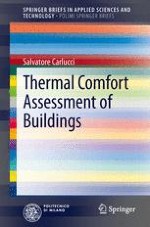2013 | OriginalPaper | Buchkapitel
4. The Long-Term Percentage of Dissatisfied
verfasst von : Salvatore Carlucci
Erschienen in: Thermal Comfort Assessment of Buildings
Verlag: Springer Milan
Aktivieren Sie unsere intelligente Suche, um passende Fachinhalte oder Patente zu finden.
Wählen Sie Textabschnitte aus um mit Künstlicher Intelligenz passenden Patente zu finden. powered by
Markieren Sie Textabschnitte, um KI-gestützt weitere passende Inhalte zu finden. powered by
